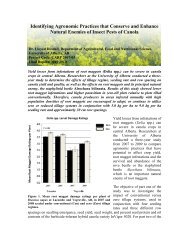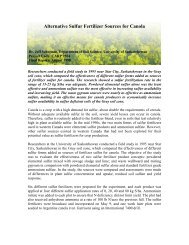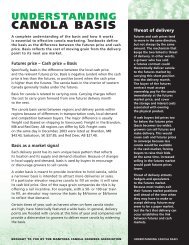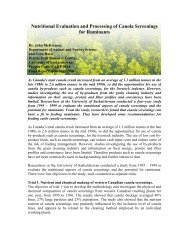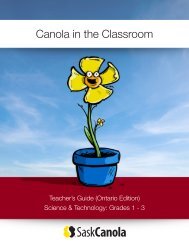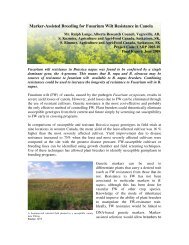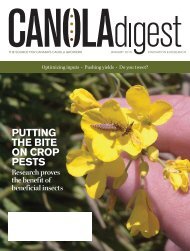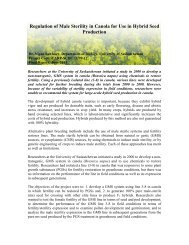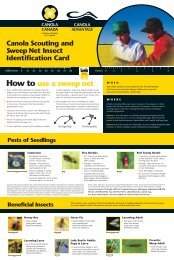Biology and Control of the Cabbage Seedpod Weevil ... - SaskCanola
Biology and Control of the Cabbage Seedpod Weevil ... - SaskCanola
Biology and Control of the Cabbage Seedpod Weevil ... - SaskCanola
Create successful ePaper yourself
Turn your PDF publications into a flip-book with our unique Google optimized e-Paper software.
<strong>Biology</strong> <strong>and</strong> <strong>Control</strong> <strong>of</strong> <strong>the</strong> <strong>Cabbage</strong> <strong>Seedpod</strong> <strong>Weevil</strong> - A New Pest <strong>of</strong>Canola in AlbertaDr. Lloyd Dosdall, Alberta Agriculture <strong>and</strong> Rural Development, EdmontonProject Code: CARP 9908Final Report: March 2001The cabbage seedpod weevil was first discovered in 1995 in canola fields in Alberta;<strong>and</strong> by 1999 serious outbreaks occurred throughout sou<strong>the</strong>rn <strong>and</strong> central Alberta.Through this study researchers determined aspects <strong>of</strong> cabbage seedpod weevil biology,monitoring strategies <strong>and</strong> potential chemical insecticides for control. Results indicatethat canola growers need to scout <strong>the</strong>ir crops early <strong>and</strong> monitor populations to plan forinsecticide control if necessary.In 1995, <strong>the</strong> first cabbage seedpod weevil (Ceutorhynchus obstrictus) was observed incanola fields in Alberta. In 1999 <strong>and</strong> 2000, outbreaks <strong>of</strong> <strong>the</strong> cabbage seedpod weeviloccurred extensively throughout sou<strong>the</strong>rn <strong>and</strong> central Alberta, with population densitiesas high as 15 to 80 adults per sweep net sample. The threshold level used in Alberta was3 to 4 adults per sweep.A three-year project was initiated in 1998 to determine important aspects <strong>of</strong> <strong>the</strong>phenology, distribution <strong>and</strong> control <strong>of</strong> C. obstrictus in spring canola in Alberta.Researchers needed this information for developing an integrated management strategyfor this pest. The objectives <strong>of</strong> <strong>the</strong> project were to determine aspects <strong>of</strong> biology, naturalenemies <strong>and</strong> appropriate monitoring strategies for cabbage seedpod weevil. Researchersalso wanted to monitor changes in <strong>the</strong> distribution <strong>and</strong> abundance <strong>of</strong> populations <strong>and</strong> toevaluate chemical insecticides for control <strong>of</strong> C. obstrictus.Research results from 1998 <strong>and</strong> 1999 provided good information for researchers,however poor growing conditions <strong>and</strong> lack <strong>of</strong> data prevented researchers from using anyresults from 2000. The research results show that adults <strong>of</strong> cabbage seedpod weevilinvade canola crops in spring, with abundance levels increasing from <strong>the</strong> seedling to <strong>the</strong>flowering stages. Crops become particularly susceptible to infestation by adults when<strong>the</strong>y reach <strong>the</strong> bud stage, <strong>and</strong> growers should monitor crops carefully from <strong>the</strong> bud stagethrough until pod ripening. St<strong>and</strong>ard sweep net samples are recommended for monitoringpopulations.The research also found that adult weevils are <strong>of</strong>ten clumped near field edges early in<strong>the</strong>ir invasion phase <strong>of</strong> canola crops. Growers should monitor field edges in <strong>the</strong> rosettestage to identify time <strong>of</strong> invasion, which may mean <strong>the</strong>y only need to spray field edgesra<strong>the</strong>r than <strong>the</strong> entire crop. Adult weevils also migrate to cruciferous weeds (e.g.
flixweed, pennycress, hoary cress, wild mustard) <strong>and</strong> volunteer canola early in <strong>the</strong> seasonbefore <strong>the</strong> canola goes into bud. Therefore, growers should use management strategies tominimize <strong>the</strong>se weeds <strong>and</strong> remove important refuge sites for weevil adults.Source: L. DosdallResearchers evaluated potentialinsecticides <strong>and</strong> found that <strong>the</strong>syn<strong>the</strong>tic pyrethroid compounds(eg. deltamethrin or Decis® <strong>and</strong>cyhalothrinp-lambda or Matador®)were <strong>the</strong> most effective forreducing populations. Theseproducts are known to have littleresidual insecticidal activity, whichis a key benefit when sprayingcrops in early flower whenpollinators are abundant.Researchers also found that crops<strong>of</strong> B. napus are very susceptible to infestations <strong>of</strong> cabbage seedpod weevil, however B.juncea appears to be less susceptible <strong>and</strong> S. alba is completely resistant. Therefore, inareas infested annually by high densities <strong>of</strong> cabbage seedpod weevil, growers shouldconsider sowing B. juncea or S. alba instead <strong>of</strong> B. napus.Researchers found little evidence <strong>of</strong> parasitism in adults or larval populations. Oneparasitoid species was reared from a weevil population near Lethbridge, <strong>and</strong> appears tobe <strong>the</strong> same species responsible for significant parasitism <strong>of</strong> this pest in <strong>the</strong> northwesternUS <strong>and</strong> Europe. Growers can conserve natural enemy populations by avoiding insecticideapplications unless weevil populations exceed <strong>the</strong> economic threshold.Scientific PublicationsFox, A.S., <strong>and</strong> L.M. Dosdall. 2003. Reproductive biology <strong>of</strong> Ceutorhynchus obstrictus(Coleoptera: Curculionidae) on wild <strong>and</strong> cultivated Brassicaceae in sou<strong>the</strong>rnAlberta. Journal <strong>of</strong> Entomological Science 38: 365-376.Fox, A.S., S.R. Shaw, L.M. Dosdall, <strong>and</strong> B. Lee. 2004. Microctonus melanopus(Ru<strong>the</strong>) (Hymenoptera: Braconidae), a parasitoid <strong>of</strong> adult cabbage seedpodweevil (Coleoptera: Curculionidae): Distribution in sou<strong>the</strong>rn Alberta <strong>and</strong> femalediagnosis. Journal <strong>of</strong> Entomological Science 39: 350-361.Dosdall, L.M., <strong>and</strong> M.A. McFarlane. 2004. Morphology <strong>of</strong> <strong>the</strong> pre-imaginal life stages<strong>of</strong> <strong>the</strong> cabbage seedpod weevil, Ceutorhynchus obstrictus (Marsham) (Coleoptera:Curculionidae). The Coleopterists’ Bulletin 58: 45-52.Dosdall, L.M., <strong>and</strong> D.W.A. Moisey. 2004. Developmental biology <strong>of</strong> <strong>the</strong> cabbageseedpod weevil, Ceutorhynchus obstrictus (Coleoptera: Curculionidae), in spring
canola, Brassica napus, in western Canada. Annals <strong>of</strong> <strong>the</strong> Entomological Society<strong>of</strong> America 97: 458-465.



